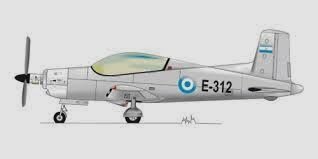This was a trainer projected c. 1976, that would employ a Turbomeca Aztaou XIV F
General characteristics
Hulaczuk, Sergio; Héctor Vaccaro (September–October 2007). "Ficha técnica Nº 65: Entrenadores". Aeroespacio (579)
.Hulaczuk, Sergio; Héctor Vaccaro (September–October 2007). "Ficha técnica Nº 65: Entrenadores". Aeroespacio (579)
General characteristics
- Crew: Two, pilot and instructor
- Length: 11.30 m (37 ft 1 in)
- Wingspan: 10.53 m (34 ft 7 in)
- Height: 3.45 m (11 ft 4 in)
- Wing area: 19.4 m2 (209 sq ft)
- Empty weight: 1,460 kg (3,220 lb)
- Gross weight: 2,528 kg (5,573 lb)
- Powerplant: 1 × Turbomeca Astazou XIV F , 405 kW (543 hp)
- Maximum speed: 412 km/h (256 mph, 222 kn)
- Range: 1,080 km (670 mi, 580 nmi)
- Service ceiling: 6,750 m (22,150 ft)
- 2 × fixed, forward-firing 7.62 mm machine guns in wings
- disposable stores on two underwing hardpoint
- The expense produced by the flight training of military crews has a significant impact on the budget allocated to defense. The trend that can be seen today is that jet trainers, until recently the backbone of the training system, are being displaced by the smaller and cheaper turboprop trainers. It is that the significant increase in fuel makes the turboprop a more appropriate engine to maintain the operational capacity of combat pilots. For this reason, aircraft such as the EMB-312 Tucano, Pilatus PC-7 and PC-9 are increasingly popular in the Air Forces of military powers.
But where the number of flight hours is limited, either as a result of internal policies or the size of the Armed Forces, piston-engined primary trainers can still be seen.
Argentina currently has a first echelon equipped with B-45 Mentor, where fighter pilots make their first weapons to move on to the EMB-312 and finally the IA-63 Pampa.
But this scenario could have been different, if certain projects like the turboprop Mentor or the IA-62 had been able to get past the preliminary stage.
Since comments have already been made about the Mentor with the Aztazou engine, this time we will focus on the IA-62, an interesting product of the design team of the Military Aircraft Factory (FMA), also headed by Ing. Ruiz.
It can be assured that in many cases, the similarities in the geometries and motor powers of some aircraft are not accidental, since one of the methods used to carry out the preliminary projects is to analyze equivalent models in order to develop a database that allows guiding the line of work.
Although there are no precise details about the development of the IA-62, it is likely that the Pilatus P3B/PC7, as well as the FAA Mentor repowering project with Aztazou, could have provided baseline information, which allowed a firmer advance. in the general dimensioning of the model. The origins of the IA-62 lie in an FAA requirement for a B-45 replacement aircraft, equipped with full IFR instrumentation and secondary RECO-COIN capability. During a tactical mission, the aircraft would have to be flown with a pilot, equipped with a 7.65mm machine gun pod on each wing and possess the ability to carry different weapons or reconnaissance equipment. The experience gained by the FMA with the Turbomeca Aztazou, installed on the IA-58 Pucará, made this engine a safe candidate for the model (in fact, this engine had no other advantage over other existing power plants on the market). Always according to the requirement, the pressurization and eventually a conditioning of the cabin was desirable. The all-metal structure would be designed based on the MIL-A-8860 and MIL-A-8870 (Aircraft Strength and Rigidity) standards, already applied on the IA-58A.
The wing plant was made up of three parts, of which the central one was rectangular and the outer ones were trapezoidal. NACA 2415 profiles were used at the root and NACA 2409 at the toecaps.
The vision of the future revealed by the technical team was not matched by the prevailing situation then, when a cheaper fuel than these days did not justify the higher initial investment that the purchase (much less the design) of an airplane meant. equipped with turboprop. That is why, shortly after a scale model was presented at the Le Bourget festival in 1978, the project was cancelled, possibly for dest. That is why, shortly after a scale model was presented at the Le Bourget festival in In 1978 the project was cancelled, possibly to allocate the limited economic resources available to another model under development, the IA-63 Pampa
Hulaczuk, Sergio; Héctor Vaccaro (September–October 2007). "Ficha técnica Nº 65: Entrenadores". Aeroespacio (579)
.Hulaczuk, Sergio; Héctor Vaccaro (September–October 2007). "Ficha técnica Nº 65: Entrenadores". Aeroespacio (579)
Attachments
Last edited:

